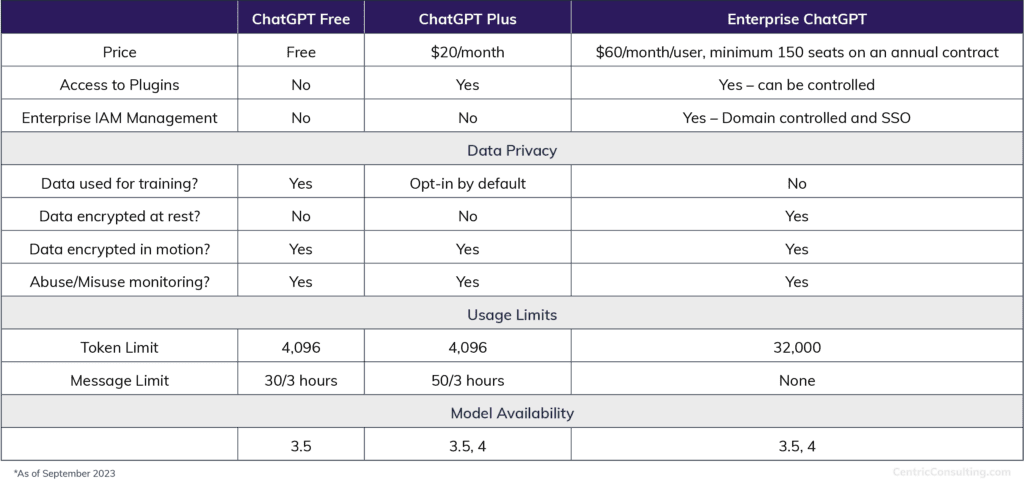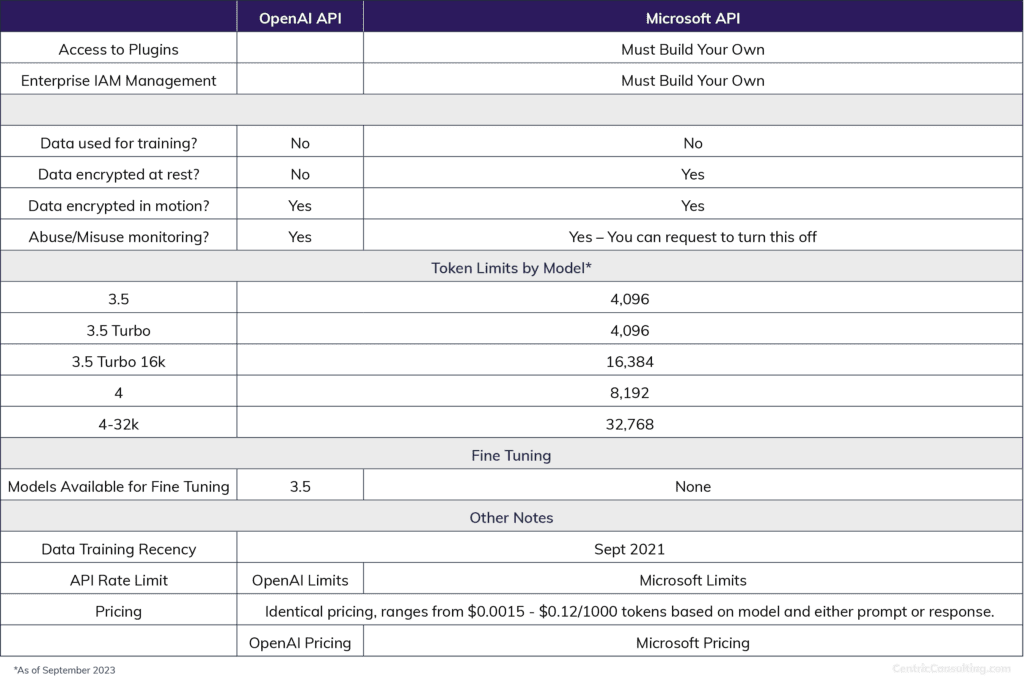AI Chatbots are gaining popularity for their ability to provide personalized customer experiences through natural conversations. There are numerous platforms that offer similar capabilities, making it challenging to select the right one for your organization. We’ll compare OpenAI’s ChatGPT and Microsoft’s Bing Chat to help you decide.
ChatGPT took the world by storm after its launch in November 2022, showcasing the impressive power of large language models (LLMs.) Microsoft now leverages OpenAI’s models in Bing Chat. Both services aim to make chatbots and AI assistants useful and safe for mainstream audiences, and their advanced capabilities are doing exactly that.
Businesses are becoming more excited than ever about chatbots’ potential to provide users with helpful information, tailored customer service experiences, and even entertainment — all through natural conversations. With numerous platforms delivering similar capabilities, how can your organization determine which service to use?
In this blog, we will focus on three of the top options when considering investing in a chatbot. All are powered by the same underlying models, but each offers different nuances to their services. The options we will consider are:
- OpenAI’s ChatGPT service – offered in free, paid and enterprise tiers.
- Microsoft’s AI-powered Bing Chat – offered in free and enterprise versions.
- Custom chatbots that use either OpenAI’s or Microsoft’s APIs.
We’ll compare the features, limitations, pricing, and use cases of these options. Whether you want an out-of-the-box chatbot or plan to build your own, this guide will help you decide which service is the best fit. The capabilities of AI chatbots are evolving rapidly, so understanding the current landscape is important for individuals and businesses exploring how to leverage this technology.
OpenAI’s ChatGPT
OpenAI is a research organization committed to ensuring that artificial general intelligence benefits humanity. The organization has several products – ChatGPT Free, ChatGPT Plus, and an enterprise offering, Enterprise ChatGPT.
All three offerings maintain conversation history so long as it continues to fit within the token limit window. At that point, the LLM does not use older portions of the conversation. OpenAI’s ChatGPT offerings are all based on training data as of September 2021, so more recent information is not available to the models by default. Plugins provide an awkward approach to incorporating more recent, though limited, information, but only via ChatGPT Plus and Enterprise ChatGPT.
ChatGPT Free: This service is for consumers who are just getting started with AI chatbots. It offers access to the GPT 3.5 model with a no-frills approach. The major advantage is that it’s free and great for experimentation. But, on the downside, access is based on the available capacity of the servers, which can be limited during peak business hours.
ChatGPT Plus: This offering is a significant step up from the free version. A full-featured, consumer-grade Chatbot allows users to choose between GPT 3.5 or GPT 4 models. That flexibility is helpful because GPT 3.5 is faster when you need an answer quickly, while GPT 4 is more accurate and can manage longer prompts and conversations for deeper dives.
In addition, ChatGPT Plus provides access to an ecosystem of plugins and advanced data analysis. You can even use personally developed (not public) plug-ins. At this level, you also gain access to Advanced Data Analysis, which will write and execute code in a sandbox. With advanced data analysis you can upload an Excel file, ask the chatbot to analyze it, and produce graphs for you. ChatGPT Plus is suited for individuals looking for a fully featured personal assistant but who do not have access to one via their enterprise.
Enterprise ChatGPT: OpenAI gears its enterprise offering towards businesses that wish to leverage ChatGPT’s capabilities without the need to build their own. The enterprise service comes with every feature of the consumer-grade ChatGPT Plus, with added controls for access and authorization of services, additional data encryption, and an administrative dashboard to monitor the organization’s use.
Below is a quick comparison of OpenAI’s offerings*:
Microsoft Bing Chat
Microsoft offers AI chat services through Bing Chat and Bing Chat Enterprise, using an underlying technology provider in the form of a fine-tuned OpenAI GPT-4 model.
In April 2023, Microsoft secured a 49 percent stake in OpenAI via a $13 billion investment. With the investment came the partnership to allow Microsoft to run GPT-3.5 and GPT-4 models on Microsoft infrastructure and offer services to their clients instead of requiring clients to be OpenAI customers. Plainly stated, Bing Chat is isolated from OpenAI, but it uses a licensed version of OpenAI’s GPT models.
Bing Chat is only available through Edge Browser, and users must sign in to a personal or corporate Microsoft account. The free and enterprise versions are virtually identical and include a creativity selection feature (Creative, Balanced, Precise) and extra functionality to generate insights on the current webpage. The ability to use Bing Chat to search the web and incorporate the current web page information is a defining difference between OpenAI’s offerings and Bing Chat’s offerings. Not only can Bing Chat do that, but it can also summarize public Microsoft Office documents open in a web browser.
While Bing Chat can incorporate more recent information, it does not have access to OpenAI’s plugin ecosystem, nor does it have advanced data analysis capabilities. You should view Bing Chat as exactly that — a Bing-driven search personal assistant. It can generate responses like OpenAI, but always in a more limited fashion. For example, it does not generate full-scale blog content in one pass.
Nevertheless, Bing Chat is a free service that’s a great medium for experimenting and gaining experience with GPT models, especially when integrating website content into search result insights.
Bing Chat Enterprise: The enterprise version of Bing Chat mirrors the free version, with an added layer of security. Notably, this version adheres to the Commercial Data Protection mandate, which ensures it doesn’t use the data, prompts and responses for model training. Also, while Bing Chat Enterprise can search and return Microsoft 365 documents, it cannot access those documents. Therefore, Bing Chat Enterprise cannot perform any actions based on their content.
Copilot Implications: A perennial question we get is about the impact of Copilot tools and Bing Chat Enterprise. As of September 2023, based on publicly available roadmap items, Copilot and Bing Chat Enterprise will not have any interaction with each other. Copilot tools focus on accelerating productivity and creativity within the application suite they serve.
Build Your Own Chatbot
If your priorities include maximum flexibility and control, building your own AI chatbot using OpenAI’s API LLMs may be the best option. With a build-your-own option, you must build your interface and security controls, but you can extend your chatbot with additional capabilities.
Fortunately, we have a baseline approach to building your chatbot to maximize flexibility, including the ability to use OpenAI’s plugin ecosystem. However, the consumption-based cost structure can make budgeting a challenge. Still, for many organizations that want to integrate ChatGPT into their existing applications or workflows, build-your-own is the only long-term viable option.
One important note about OpenAI and Microsoft’s API endpoints: With OpenAI, you can access any model via a singular endpoint by passing in the model’s name, e.g., model=‘gpt-4’ or model=‘gpt-3.5-turbo-16k’. With Microsoft, your API endpoint only allows access to a singular deployed model. For example, if you use GPT-3.5 for fast responses and then switch to GPT-4 for more in-depth responses, you’ll need to code for two API endpoints with Microsoft, which corresponds to two different deployments.
Given the identical nature of the API and the underlying models, many aspects of comparison are identical between OpenAI and Microsoft.
Our Recommendation
ChatGPT and Microsoft Bing come with unique capabilities, and the challenge lies in understanding the subtle, nuanced differences that may significantly impact their performance within specific use cases. As a result, it becomes exceedingly important to make a well-informed decision when choosing between these offerings. We recommend you carefully consider your unique business needs, technical capabilities, and budget before committing to any of these options.




